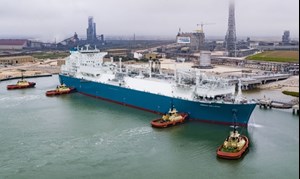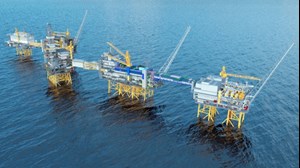The push to reduce carbon emissions with renewables and emerging technologies has caused many short-sighted government officials to enact legislation to restrict oil and gas activity to the detriment of the people they represent. However, forward thinking administrators in Norway have taken a different approach and turned the “global warming problem” into an opportunity to expand their offshore oil and gas production, while still developing lower-carbon energy. The Norwegians’ comprehensive plan also includes a major expansion of offshore wind and electrification of oil and gas installations.
Two-pronged approach. According to the U.S. International Trade Association, “after 50 years of oil and gas production, the diversification of offshore energy in Norway continues, and now the basins are being developed to become power hubs, integrating large-scale offshore wind projects and power grids to neighboring countries. The plan also includes electrifying oil and gas platforms while developing infrastructure for CCUS and developing hydrogen supply chains. This is a collaborative effort, relying on international/EU policies and technology input from foreign companies.” While Norway has announced plans to double its capacity to export renewable power, their offshore exploration and production activities are thriving.
Start of the Norwegian oil industry. Ekofisk was discovered by Phillips Petroleum in 1969 and remains one of the country’s most important oil fields. It was the first North Sea oil discovery after extensive exploratory drilling was triggered by the massive onshore Groningen natural gas discovery in the Netherlands in 1959. In 1971, Phillips started producing Ekofisk directly to tankers from four subsea wells. The Ekofisk center now contains a vast complex comprised of 29 platforms, creating a transportation hub for surrounding fields, including Valhall, Hod, Gyda and Ula.
Norway promoting record-setting offshore exploration. In May, Aker BP announced a significant oil discovery at its Øst Frigg Beta/Epsilon exploration well in the Yggdrasil area, Norwegian North Sea. When the Øst Frigg Beta/Epsilon wildcat well reached its target depth, the team had drilled 8,168 m, including a long horizontal section through the reservoir. It is Norway’s longest-ever exploration well.
Preliminary estimates indicate a gross recoverable volume of 53-90 MMboe, surpassing the pre-drill estimate of 18-45 MMboe. The discovery enhances the resource base for the Yggdrasil development, estimated to contain 650 gross MMboe. The discovery contributes to increasing the resource base in the ongoing Yggdrasil development by approximately 10%. The plan for development and operations (PDO) was submitted to Norwegian authorities in December 2022, with production scheduled to commence in 2027.
The oil discovery is within production licenses 873 and 442. In license 873, ownership is Aker BP (operator, 47.7%), Equinor (40%) and PGNiG Upstream Norway (12.3%). In license 442, the partnership comprises Aker BP (operator, 87.7%) and PGNiG Upstream Norway (12.3%). Øyvind Seljebotn, SVP Aker BP, said, “we are extremely pleased with the results of the Øst Frigg Beta/Epsilon well. The discovery is a significant addition to the Yggdrasil development. We see further upside potential around Yggdrasil, and in collaboration with our partners, we will continue active exploration in the area.”
Production from Equinor’s Johan Sverdrup field reaches record high. During a capacity test at Johan Sverdrup, the field reached a record-high production level of 755,000 bopd, Fig. 1. This equals approximately 6-7% of daily European oil consumption. “This capacity test at Johan Sverdrup confirms technically robust facilities and was performed safely with no unwanted incidents,” said Marianne Bjelland, Johan Sverdrup VP, Equinor. “This is an important milestone and the result of systematic and targeted efforts.”
Johan Sverdrup has estimated reserves of 2.7 Bboe and produces 80-90% less CO2 emissions, compared to the global average. The field generates 3,400 jobs per year and the production will contribute about $84.7 billion to the state through taxes and direct ownership over the field’s lifespan.
Technically challenging tie-back. Neptune Energy has started production from Fenja oil and gas field, after connecting a long-distance tie-back to the Njord A semisubmersible platform in the Norwegian Sea. Fenja, 120 km north of Kristiansund in 325-m water depth, will eventually deliver 35,000 boed via two oil wells, with pressure support from one water injector and one gas injector.
The development comprises two subsea templates with a 36-km, electrically trace-heated (ETH) pipe-in-pipe, taking Fenja’s oil to Njord A field, to the platform for processing and onward transport. The ETH arrangement is needed because of Fenja’s high wax content. Following a shutdown, hydrocarbons in the pipeline must be warmed above 28°C before resuming the flow. In normal production mode, the temperature in the pipeline is well above this temperature. Neptune estimates the field contains 50-75 MMboe (75% oil and 25% gas).
More offshore drilling. The Norwegian Ministry of Petroleum and Energy has approved the plan to further increase production in the North Sea by approving a PDO for Tyrving in the Alvheim area. The development will be operated by Aker BP and license partners Petoro AS and PGNiG Upstream Norway. Total investments will be $700 million, with recoverable resources estimated at 25 MMboe. Production is scheduled to start in the first quarter of 2025.
A 50% increase in NCS oil production. Vår Energi and Halliburton have entered into a long-term strategic relationship for drilling services to further improve drilling and well performance and enhance value creation. The planned relationship covers drilling services related to exploration and production drilling for Vår Energi across the entire Norwegian Continental Shelf (NCS). The planned relationship has a duration of five years, with options for an additional four years in total. Vår Energi’s activities span the entire NCS, with a diversified portfolio of 158 licenses and 39 producing fields. Drilling activities are focused around four strategic hubs in the Balder/Grane area, the North Sea, the Norwegian Sea and the Barents Sea.
Ingrid Sølvberg, Vår Energi EVP Technology, Drilling and Subsurface said, “We are on track to deliver on our end-2025 production target, an increase of 50% from today’s level. Combined with our proven best-in-class exploration capabilities, teaming up with Halliburton will be a key enabler in meeting our ambitious long-term growth targets. Collaboration with strong partners will be a driving force in technology development, contribute to reducing costs and emissions, while also improving efficiency and HSE performance,” Sølvberg concluded.
Data investment removes all doubt. Halliburton launched Diskos 2.0 National Data Repository (NDR) for the Norwegian Petroleum Directorate. Diskos 2.0 is the industry’s first fully cloud native NDR implementation. The database stores critical exploration and production data that are vital to drive investments in Norway’s oil and gas industry. The upgraded system incorporates advanced automation and artificial intelligence capabilities to derive better insights from the data, reduce cost per byte and improve scalability to manage over 28 petabytes of data, including a copy, in a multi-cloud environment.
Diskos connects to third-party services to add new functionalities. It allows members to instantly access the full range of seismic, well and production data in a fully functional petro-technical software environment without moving data from the NDR to a local network. “The new system provides operators and key oil and gas stakeholders with a clean, transparent information and data management environment,” said Louis Vos, Assistant Director, National Petroleum Directorate. “It ensures that our members can access and perform data processing, interpretation and analytics without having to copy it first.” Nagaraj Srinivasan, SVP Landmark, added, “Halliburton’s digital ecosystem shortens the path from data to insights for members. It provides a boost for exploration and investments in the Norwegian shelf and plays a vital role to fortify Norway’s position as a predictable, long-term global supplier of energy.”
Another long-term commitment. Equinor has signed a 15-year LNG deal with Cheniere, doubling its purchases of U.S. LNG, as the company looks to replace Russian gas supplies, Fig. 2. The deal is for an additional 1.75 million tons a year in long-term supply from Cheniere Energy. Equinor agreed to buy a similar volume from Cheniere in an agreement struck one year ago.

Europe has turned to alternative nations like the U.S. after Moscow’s invasion of Ukraine last year, with a particular focus on LNG imports. Equinor, which is already supplying the region with pipeline gas and LNG from its plant in the north of Norway, has been seeking more deals that allow it to sell the gas on to European or Asian customers at a profit. “Europe will need natural gas to ensure flexible energy on demand to support the build-out of more intermittent renewables, and LNG will play an important role,” said Helge Haugane, Equinor’s SVP. “In other markets, for example in Asia, demand for LNG is expected to grow.”
Norway’s brilliant strategy to replace Russian supply. While power-hungry quasi-dictators in Western countries continue to spout climate change rhetoric to achieve their political agenda and wipe out the oil and gas industry, Norway has set a shining example of how to efficiently achieve carbon reduction goals while achieving energy abundance/security. The aggressive development of mature producing regions is generating immense tax revenue and high-paying jobs for the Norwegian people. Maybe Western countries should use the same formula to reduce energy prices and protect their citizens from shortages caused by unreliable green ener

- Dallas Fed: Outlook improves, even as activity little changed; break-even prices increase (April 2024)
- The last barrel (February 2024)
- Oil and gas in the Capitals (February 2024)
- What's new in production (February 2024)
- First oil (February 2024)
- E&P outside the U.S. maintains a disciplined pace (February 2024)



